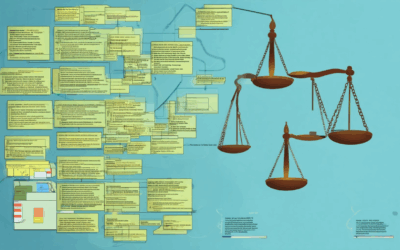Evaluating Nonprofit Programs (NPOs) is crucial for ensuring their impact aligns with organizational goals and community expectations. For individuals new to this process, navigating the complexities of program evaluation can feel overwhelming. Whether assessing the effectiveness of a charity’s initiatives or analyzing the performance of educational programs, understanding how to evaluate NPO programs is essential for making informed decisions. This guide offers a comprehensive approach, providing clear, step-by-step strategies that anyone can follow, regardless of prior experience. From measuring performance metrics to exploring various evaluation methods, this resource covers everything needed to assess programs effectively. By addressing unique challenges, such as evaluating programs for specific demographics like seniors or kids, this guide ensures a holistic understanding of evaluation processes. With practical insights and actionable advice, readers will gain the tools necessary to evaluate NPO programs with confidence and precision.
Key Takeaways
- Understand key KPIs to measure program success and financial health.
- Focus on metrics like fundraising efficiency, program impact, and donor retention.
- Apply the 4 Ps of KPI (Product, Place, Promotion, Price) for a comprehensive evaluation.
- Use financial metrics to assess revenue, expenses, and liquidity.
- Utilize data to drive informed decisions and enhance program effectiveness.
- Align KPIs with organizational goals to ensure mission alignment.
- Monitor financial health through regular benchmarking and performance reviews.
- Prioritize donor engagement to build lasting supporter relationships.
- Leverage technology for effective data collection and analysis.
- Implement actionable insights to refine strategies and achieve greater impact.
- Ensure transparency and accountability to maintain trust with stakeholders.
- Combine quantitative and qualitative measures for a well-rounded evaluation.

How to Measure the Performance of a Non-Profit Organization
Measuring the performance of a non-profit organization involves tracking various metrics that reflect its mission achievement, financial health, and operational efficiency. Here are the key metrics to consider:
- Program Impact Metrics
- Participant engagement rates
- Service delivery outcomes
- Client satisfaction scores
- Change in community conditions
- Donor Acquisition and Retention Metrics
- Donor retention rate
- Average gift size
- Cost per donor acquisition
- Total donations raised
- Financial Health Metrics
- Revenue diversification
- Expenses as a percentage of revenue
- Net asset ratio
- Liabilities to assets ratio
- Operational Efficiency Metrics
- Program cost per unit outcome
- Volunteer recruitment and retention rates
- Average time spent by volunteers
- Event attendance rates
- Community Engagement Metrics
- Social media follower growth
- Website traffic analytics
- Email subscriber growth
- Community outreach impact
- Board Performance Metrics
- Board member involvement
- Committee activity levels
- Strategic alignment with organizational goals
- Board meeting attendance
How to Evaluate the Effectiveness of a Program
To evaluate the effectiveness of a program, follow these organized steps:
- Define Clear Objectives : Establish specific, measurable goals aligned with the program’s purpose. Clearly articulate what success looks like.
- Identify Key Performance Indicators (KPIs) : Select quantitative and qualitative metrics to track progress. Examples include participation rates, output achievements, or community impact metrics.
- Monitor and Evaluate Regularly : Conduct periodic assessments, such as quarterly reviews, to monitor progress and compare outcomes against targets.
- Benchmark Against Standards : Compare program outcomes with industry benchmarks or similar initiatives to gauge performance relative to others.
- Collect Data Through Various Means : Gather data using surveys, focus groups, interviews, and statistical analysis to capture both quantitative and qualitative insights.
- Analyze and Report Findings : Utilize tools like dashboards to present data visually and provide actionable recommendations based on results.
- Solicit Stakeholder Feedback : Engage participants, partners, and funders to understand program effectiveness from diverse perspectives.
- Document Evaluation History : Maintain records of evaluations, feedback, and program adjustments for future reference and replication purposes.
- Implement Continuous Improvement : Use evaluation insights to iterate and enhance the program, ensuring it adapts to changing needs and contexts.
By systematically applying these steps, you can thoroughly assess program effectiveness and drive future improvements.

Methods of Program Evaluation
Program evaluation is a critical process for assessing the effectiveness and impact of nonprofit programs. Below are the primary methods used to evaluate programs:
1. Quantitative Methods
Quantitative methods involve numerical data collection and analysis to measure outcomes and impacts. These methods are often used to determine whether a program achieves its intended goals.
- Experimental Designs: Compare the effects of a program with a control group to isolate variables and measure changes.
- Quasi-Experimental Designs: Similar to experiments but without random assignment, often used due to ethical constraints or program limitations.
- Surveys: Collect data through structured questionnaires to gather quantitative insights on program outcomes and participant experiences.
2. Qualitative Methods
Qualitative methods focus on understanding the nature and meaning of program experiences. These methods provide deeper insights into program implementation and participant perceptions.
- Interviews: One-on-one conversations with participants, stakeholders, or staff to gain in-depth insights.
- Focus Groups: Group discussions with a small number of participants to explore shared experiences and opinions.
- Case Studies: Detailed examinations of individual cases to identify patterns and lessons learned.
3. Mixed-Methods Approach
Combining quantitative and qualitative methods allows for a more comprehensive evaluation by capturing both numerical data and subjective experiences.
- Pretest and Posttest Surveys: Measure changes in knowledge, skills, or attitudes before and after participating in the program.
- Focus Groups with Surveys: Combine group discussions with quantitative data to triangulate findings and enhance reliability.
4. Process Evaluation
Process evaluation focuses on examining how a program is implemented, ensuring alignment with objectives and addressing implementation challenges.
- Implementation Logs: Document key events, challenges, and adjustments made during program execution.
- Participant Feedback: Regularly collect feedback from participants to identify issues and areas for improvement.
Key Considerations
To ensure effective program evaluation, consider the following:
- Alignment with Goals: Evaluate programs against their stated objectives to measure success.
- Participant Input: Engage participants in the evaluation process to get honest feedback.
- Long-term Impact: Assess both immediate and long-term effects of the program.
By systematically applying these methods, nonprofits can gain valuable insights into their program performance, enabling them to refine strategies and maximize their impact. For more resources on program design and evaluation, visit our Nonprofit Program Design and Evaluation Tools for Nonprofits pages.

What is a KPI for a Non-Profit Organization?
A Key Performance Indicator (KPI) for a non-profit organization is a measurable metric used to evaluate the effectiveness of its operations and achievements against its goals. These indicators are crucial for assessing progress toward mission objectives, ensuring efficient use of resources, and demonstrating impact to stakeholders.
Here are 20 essential KPIs for non-profits:
- Fundraising Efficiency : Measures the ratio of funds raised to expenses, indicating how cost-effective fundraising efforts are.
- Program Impact : Assesses the outcomes of specific programs, such as the number of individuals served or changes in their circumstances.
- Donor Retention Rate : Tracks the percentage of donors who continue to support the organization over time.
- Volunteer Engagement : Measures the number and satisfaction of volunteers contributing to programs.
- Financial Stability : Evaluates the organization’s ability to sustain operations and plan for future activities.
- Brand Awareness : Reflects the recognition and reputation of the non-profit among its target audience.
- Social Media Engagement : Monitors interactions, followers, and engagement rates on social platforms.
- Event Attendance : Tracks the number of participants in key events, such as auctions or galas.
- Community Outreach : Measures the reach and impact of outreach initiatives, like workshops or educational programs.
- Grant Acquisition : Counts the number and size of grants received, indicating funding success.
- Website Traffic : Analyzes visitor numbers and bounce rates on the organization’s website.
- Communication Effectiveness : Assesses the reach and understanding of communication materials sent to stakeholders.
- Board Involvement : Tracks participation in board meetings and committee activities.
- Membership Growth : Measures the increase in active members contributing to the organization’s community.
- Advocacy Impact : Evaluates the influence of advocacy campaigns on policy changes or public awareness.
- Program Completion Rates : Determines how many programs successfully meet their targets and timelines.
- Revenue diversification : Checks reliance on a single funding source by examining the mix of donations, grants, and other income streams.
- Stakeholder Satisfaction : Surveys donors, volunteers, and partners to gauge overall satisfaction and loyalty.
- Strategic Plan Implementation : Ensures that strategic goals are being met and timelines are maintained.
- Impact Reporting : Assesses the quality and timeliness of reporting on program outcomes and financial status.
These KPIs collectively help non-profits align their actions with their missions, engage stakeholders effectively, and maintain accountability to donors and the communities they serve.
What are the 4 P’s of KPI?
The 4 P’s of KPI for marketers are Product , Place , Promotion , and Price . These pillars help businesses measure and optimize their marketing performance effectively.
- Product: Focuses on the quality, demand, and profitability of your offerings. Key metrics include sales volume, market share, and customer satisfaction.
- Place: Relates to distribution channels and accessibility. Metrics include channel sales, inventory turnover, and geographic coverage.
- Promotion: Involves brand awareness and marketing effectiveness. Metrics include advertising spend, website traffic, and social media engagement.
- Price: Examines pricing strategy and competitiveness. Metrics include average selling price, gross margin, and pricing penetration.

Assessing Nonprofit Financial Performance
To assess the financial performance of a nonprofit organization, consider the following key metrics and approaches:
- Revenue and Expenditure Analysis :
- Total Revenue : Measure the amount of money generated through donations, grants, and other sources.
- Program Expenses vs. Total Expenses : Compare how much of the budget is allocated to program activities versus administrative costs to gauge efficiency.
- Liquidity and Solvency :
- Quick Ratio : Assess the organization’s ability to cover short-term obligations with immediate assets.
- Cash Flow : Evaluate the timing and amount of cash inflows and outflows to ensure financial stability.
- Efficiency Metrics :
- Full-Cost Coverage : Determine the percentage of total costs covered by program revenue, indicating reliance on donations.
- Fundraising Return on Investment (ROI) : Calculate the efficiency of fundraising efforts by measuring dollars raised per dollar spent.
- Financial Flexibility :
- Unrestricted Net Assets : Gauge the organization’s capacity to adapt to changes with available funds.
- Debt Management :
- Liabilities vs. Total Assets : Assess the organization’s debt levels relative to its assets for a clearer picture of financial health.
- Donor Engagement :
- Donor Retention Rate : Track how well the nonprofit retains donors, crucial for long-term sustainability.
- Industry Benchmarking :
- Compare metrics against industry standards to evaluate performance relative to peers.
- Regular Monitoring :
- Conduct assessments periodically (e.g., annually) to track progress and adjust strategies as needed.
- Actionable Insights :
- Use findings to inform strategic decisions, such as enhancing donor engagement or adjusting program allocation.
By systematically evaluating these aspects, nonprofits can gain insights into their financial health, enabling better decision-making and mission fulfillment.





0 Comments